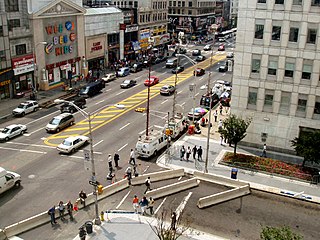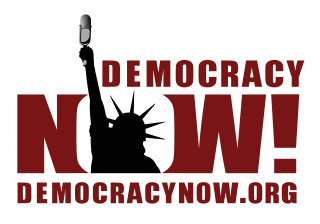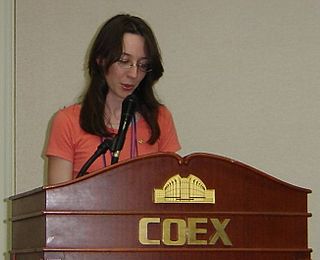Journalism is the production and distribution of reports on current events based on facts and supported with proof or evidence. The word journalism applies to the occupation, as well as citizen journalists who gather and publish information based on facts and supported with proof or evidence. Journalistic media include print, television, radio, Internet, and, in the past, newsreels.

Walter Lippmann was an American writer, reporter and political commentator. With a career spanning 60 years he is famous for being among the first to introduce the concept of Cold War, coining the term "stereotype" in the modern psychological meaning, as well as critiquing media and democracy in his newspaper column and several books, most notably his 1922 book Public Opinion.

The news media or news industry are forms of mass media that focus on delivering news to the general public or a target public. These include print media, broadcast news, and more recently the Internet.

Democracy Now! is an hour-long left-wing American TV, radio and internet news program hosted by journalists Amy Goodman, who also acts as the show's executive producer, and Juan González. The show, which airs live each weekday at 8 a.m. Eastern Time, is broadcast on the internet and by over 1,400 radio and television stations worldwide.
Agenda-setting describes the "ability to influence the importance placed on the topics of the public agenda". Agenda-setting is the manipulation of public awareness and concern of salient issues by the news media. The study of agenda-setting describes the way media attempts to influence viewers, and establish a hierarchy of news prevalence. Nations with more political power receive higher media exposure. The agenda-setting by media is driven by the media's bias on things such as politics, economy and culture, etc. The evolution of agenda-setting and laissez-faire components of communication research encouraged a fast pace growth and expansion of these perspectives. Agenda-setting has phases that need to be in a specific order in order for it to succeed.

Citizen journalism, also known as collaborative media, participatory journalism, democratic journalism, guerrilla journalism or street journalism, is based upon public citizens "playing an active role in the process of collecting, reporting, analyzing, and disseminating news and information." Similarly, Courtney C. Radsch defines citizen journalism "as an alternative and activist form of news gathering and reporting that functions outside mainstream media institutions, often as a response to shortcomings in the professional journalistic field, that uses similar journalistic practices but is driven by different objectives and ideals and relies on alternative sources of legitimacy than traditional or mainstream journalism". Jay Rosen offers a simpler definition: "When the people formerly known as the audience employ the press tools they have in their possession to inform one another." The underlying principle of citizen journalism is that ordinary people, not professional journalists, can be the main creators and distributors or news. Citizen journalism should not be confused with: community journalism or civic journalism, both of which are practiced by professional journalists; collaborative journalism, which is the practice of professional and non-professional journalists working together; and social journalism, which denotes a digital publication with a hybrid of professional and non-professional journalism.

E-democracy, also known as digital democracy or Internet democracy, is the use of information and communication technology (ICT) in political and governance processes. The term is believed to have been coined by digital activist Steven Clift. E-democracy incorporates 21st-century information and communications technology to promote democracy; such technologies include civic technology and government technology. It is a form of government in which all adult citizens are presumed to be eligible to participate equally in the proposal, development and creation of laws.

Community radio is a radio service offering a third model of radio broadcasting in addition to commercial and public broadcasting. Community stations serve geographic communities and communities of interest. They broadcast content that is popular and relevant to a local, specific audience but is often overlooked by commercial or mass-media broadcasters. Community radio stations are operated, owned, and influenced by the communities they serve. They are generally nonprofit and provide a mechanism for enabling individuals, groups, and communities to tell their own stories, to share experiences and, in a media-rich world, to become creators and contributors of media.
Alternative media are media sources that differ from established or dominant types of media in terms of their content, production, or distribution. Sometimes the term independent media is used as a synonym, referencing independence from large media corporations, but this term is also used to indicate media enjoying freedom of the press and independence from government control. Alternative media does not refer to a specific format and may be inclusive of print, audio, film/video, online/digital and street art, among others. Some examples include the counter-culture zines of the 1960s, ethnic and indigenous media such as the First People's television network in Canada, and more recently online open publishing journalism sites such as Indymedia.
Media democracy is a democratic approach to media studies that advocates for the reform of mass media to strengthen public service broadcasting and develop participation in alternative media and citizen journalism in order to create a mass media system that informs and empowers all members of society and enhances democratic values. Media is also defined as "medium" a way of communicating with others.

Citizen media is content produced by private citizens who are not professional journalists. Citizen journalism, participatory media and democratic media are related principles.
Civic journalism is the idea of integrating journalism into the democratic process. The media not only informs the public, but it also works towards engaging citizens and creating public debate. The civic journalism movement is an attempt to abandon the notion that journalists and their audiences are spectators in political and social processes. In its place, the civic journalism movement seeks to treat readers and community members as participants.

Supinya Klangnarong is a Thai media rights advocate and current vice-chair of the Campaign for Popular Media Reform (CPMR). A graduate of Chulalongkorn University, she holds a BA from the Faculty of Communication Arts, an MA from the Faculty of Journalism and Mass Communication at Thammasat University and an MA in Communication Policy and Regulations from the University of Westminster.
Digital journalism, also known as online journalism, is a contemporary form of journalism where editorial content is distributed via the Internet, as opposed to publishing via print or broadcast. What constitutes digital journalism is debated by scholars; however, the primary product of journalism, which is news and features on current affairs, is presented solely or in combination as text, audio, video, or some interactive forms like newsgames, and disseminated through digital media technology.
The Fifth Estate is a socio-cultural reference to groupings of outlier viewpoints in contemporary society, and is most associated with bloggers, journalists publishing in non-mainstream media outlets, and the social media or "social license". The "Fifth" Estate extends the sequence of the three classical Estates of the Realm and the preceding Fourth Estate, essentially the mainstream press. The use of "fifth estate" dates to the 1960s counterculture, and in particular the influential The Fifth Estate, an underground newspaper first published in Detroit in 1965. Web-based technologies have enhanced the scope and power of the Fifth Estate far beyond the modest and boutique conditions of its beginnings.

Canadian online media is content aimed at a Canadian audience through the medium of the Internet. Presently, online media can be accessed by computers, smart-phones, gaming consoles, Smart TVs, MP3 players, and tablets. The characteristics of Canadian online media are strongly shaped by the Canadian communications industry, even though their statistics and findings are more often than not associated with American research. Large media companies are increasingly on the move to start up online platforms for news and television content. The exponential growth of Canadians' dependency on online content for entertainment and information has been evident in the recent decades. However, it has proven slow for Canadian online media to catch up with the constant increase of American online media. Regardless of medium, entertainment and information hubs are not solely focusing on satisfying the audience they have, but are also heavily expanding their reach to new global audiences.
The Al Jazeera effect is a term used in political science and media studies to describe the impact of new media and media sources on global politics, namely, reducing the government and mainstream media monopoly on information and empowering groups which previously lacked a global voice. The primary example is the effect's namesake – the impact of the Al Jazeera Media Network on the politics of the Arab world.
Media regulations are rules enforced by the jurisdiction of law. Guidelines for media use differ across the world. This regulation, via law, rules or procedures, can have various goals, for example intervention to protect a stated "public interest", or encouraging competition and an effective media market, or establishing common technical standards.
Western media is the mass media of the Western world. During the Cold War, Western media contrasted with Soviet media. Western media has gradually expanded into developing countries around the world.

Radical media are communication outlets that disperse action-oriented political agendas utilizing existing communication infrastructures and its supportive users. These types of media are differentiated from conventional mass communications through its progressive content, reformist culture, and democratic process of production and distribution. Advocates support its alternative and oppositional view of mass media, arguing that conventional outlets are politically biased through their production and distribution. However, there are some critics that exist in terms of validating the authenticity of the content, its political ideology, long-term perishability, and the social actions led by the media.








